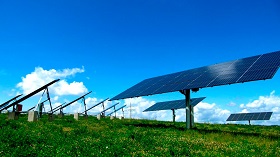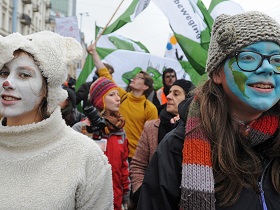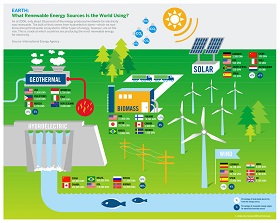Green Energy in Russia: Window-dressing, Protectionism or Genuine Decarbonisation?
Tide-mill power plant project
In
Login if you are already registered
(no votes) |
(0 votes) |
Lecturer in Law at University of Aberdeen, Legal Adviser to the IFC Russia Renewable Energy Program
The promotion of renewable energy sources in the Russian Federation has been discussed at the highest political levels since the 1990s. Although good progress has been made towards the creation of a framework for developing renewable energy, important problems remain. In 2014, Russia is still without a functioning support scheme that could stimulate the large-scale deployment of clean energy sources. Various different laws and regulations have been adopted and an official renewable energy policy is in place, at least on paper. In practice, investors in the renewable energy sector face various obstacles relating to the remaining regulatory gaps, high protectionist barriers and insufficient financial incentives to level the playing field with conventional electricity and heat generation. In the absence of a functioning renewable energy support scheme, Russia runs the risk of missing the boat of the Green Revolution and lagging significantly behind developed countries and other BRIC economies [1] regarding the clean technology sector. Moreover, not developing Russia’s considerable renewable energy potential will expose customers to the price risks inherent in fossil fuels, in particular in Russia’s isolated energy systems.
Decreasing ambition of the federal renewable energy policy: from 4.5% to 2.5% to …?
Following failed attempts in 1999 to adopt a Federal Law on Renewable Energy [2], Russian lawmakers in November 2007 introduced a legal basis for promoting renewable energy sources: the Federal Electricity Law, which obliged the Government to adopt a national renewable energy target [3]. With its 2009 Resolution on Russia’s Renewable Energy Policy in the Electricity Sector, the Government adopted a 4.5% target for green electricity consumption and production to be achieved by 2020 [4]. The Government has produced different programs of measures, outlining how it intends to achieve this target [5]. These programs’ implementation has suffered from considerable delays resulting in strong doubts whether the 4.5% target can be achieved by 2020 [6].
The perceived short term impact that Russia’s renewable energy policy could have on electricity prices and the consolidation of direct state control over the energy sector are important obstacles to any implementation of this premium scheme.
Importantly, in April 2013, the Government adopted a reduced target of 2.5% in the State Program for Energy Efficiency and the Development of the Energy Sector [7], thereby indicating that the ambitions of Russia’s renewable energy policy might be considerably reduced. In the absence of any amendment of the 4.5% proportion given in the 2009 Resolution on the Russian Renewable Energy Policy in the Electricity Sector, it could be argued that the reduced 2.5% target only applies to a certain segment of the electricity market, e.g. the wholesale market. Given this uncertainty regarding the correct interpretation of the target, it is essential for investors in Russia’s renewable energy sector that the Government clearly confirms Russia’s official renewable energy target and reaffirms its commitment to that target. As highlighted in the EU Renewable Energy Directive, “a framework that includes mandatory targets should provide the business community with the long-term stability it needs to make rational, sustainable investments in the renewable energy sector.” [8] One way of reinforcing the credibility of Russia’s target would be to establish it in the Federal Electricity Law.
The premium scheme: Abortion for short-term price concerns
Since November 2007 the Federal Electricity Law has required the Government to achieve Russia’s renewable energy target via a “premium” scheme, i.e. a mark-up on the wholesale electricity market price. However, the Government has never adopted the premium scheme, invoking legal and technical difficulties relating to implementing the premium mechanism to justify this legal breach. More importantly, the perceived short term impact that Russia’s renewable energy policy could have on electricity prices and the consolidation of direct state control over the energy sector are important obstacles to any implementation of this premium scheme. According to the International Energy Agency, “against a background of concern about high end-user electricity prices, the government appears reluctant for the moment to add higher costs into the wholesale mix by agreeing to include a premium in tariffs for new renewable-based electricity.” [9]
The Government’s concern regarding the short-term cost of the renewable energy policy disregards the medium and long-term contribution that renewable energy can make to the affordability of energy supply in Russia. Indeed, renewable energy sources (in particular wind, geothermal and solar PV energy) are characterized by much lower operating costs compared with conventional power generation. Developing renewable energy sources could shield customers, in the medium and long term, from risks relating to energy price volatility. In regions of the Russian Federation that are not endowed with fossil fuels, renewable energy could play a key role in improving energy independence – an increasingly important issue for the economic growth of several parts of the Russian Federation [10].
The capacity scheme: A unique and untested approach
In May 2013, the Government eventually adopted Decree 449 on the functioning of the capacity-based support scheme to promote renewable energy sources in Russia [11]. Decree 449 follows amendments to the Federal Electricity Law in 2010 that introduced a legal basis for a new approach to support for renewable energy in Russia. In contrast to the premium scheme, which was supposed to remunerate renewable energy facilities according to their electricity output, the new scheme is anchored in the wholesale capacity market, i.e. the market segment that remunerates power plants according to their electricity production capacity. This approach is unique: most countries promote renewable energy on the basis of the amount of electricity delivered to the network, i.e. on their output expressed in MWh – rather than on the basis of their installed capacity, expressed in MW or MWmonth [12].
In contrast to the premium scheme, which was supposed to remunerate renewable energy facilities according to their electricity output, the new scheme is anchored in the wholesale capacity market, i.e. the market segment that remunerates power plants according to their electricity production capacity.
Russia’s capacity-based approach at first sight can sound paradoxical. Indeed, most renewable energy sources are variable (intermittent) sources of electricity production. They depend on external natural factors (wind, sun) and it is thus difficult to determine their future availability to produce electricity – the major factor underlying the remuneration of power plants under Russia’s existing capacity-driven market. To address this risk of incompatibility, the Russian Government made the necessary changes to the existing capacity supply rules to integrate the variability inherent in renewable energy installations. The capacity supply rules now exempt variable renewable energy sources from the strict availability requirements governing the remuneration of conventional power plants. At the same time, in order to alleviate the risk of “steel in the ground” (i.e. the risk of promoting construction over the efficient production of renewable energy), the capacity supply rules impose minimum production levels (capacity factor) on renewable energy investments. These levels are calculated on a yearly basis, thereby making it possible for variable sources to meet this requirement.
The unique approach that Russia chose to promote renewable energy presents a risk to investors because it is untested. However, it fits well with the specific institutional framework of the Russian market and could therefore facilitate the authorities’ compliance.
Capacity tenders: Support at last, but for whom?

Energy Revolution. XXI century. Reset
In September 2013, the first tender for renewable energy projects was organized [13]. The outcome of this tender was most disappointing. No bids were submitted for small hydropower plants. Wind remained largely undersubscribed. The disappointing outcome of this first tender can be explained by the short deadline preceding the tender being held and by the very strict guarantee requirements imposed on project developers (guarantee to cover 5 % of project costs by agreements with energy companies controlling more than 2500 MW installed capacity) [14]. Moreover, the limited participation of investors can, crucially, be attributed to the high local content requirements are imposed on renewable energy projects. To benefit from support, investors must source a large part of the equipment used in their projects from Russia-based manufacturers. However, with the exception of solar PV [15], there is currently no renewable energy manufacturing industry in Russia. More importantly, considering the Government’s limited ambitions in the renewable energy field, Russia is unlikely to be considered a sufficiently attractive market for manufacturers of renewable energy equipment. The national renewable energy target is too low to convince renewable energy equipment producers to move production capacity to Russia.
To ensure the capacity-based scheme works, it is essential to significantly revise existing local content requirements for the forthcoming tenders. Fundamental changes to Russia’s local content policy in the renewable energy sector would be in line with the Government’s objective of keeping energy prices low. Indeed, as recently highlighted by OECD research, local content requirements increase the cost of renewable energy policies and thus negatively impact on energy customers and the state budget [16].
Moreover, it is essential to fundamentally revise Russia’s local content policy to ensure compliance with WTO regulations. The WTO Appellate Body recently ruled that local content requirements in Canada’s (Ontario) renewable energy tariffs violate the Agreement on Trade Related Investment Measures (TRIMS) [17]. Importantly, the Canadian local content requirements were drafted in an almost identical way to the existing Russian local content requirements, thereby raising the likelihood that the Russian policy could also be declared unlawful if a challenge is brought before the WTO dispute resolution panel.
Retail market support: How much, for how long?

Yulia Yamineva:
International agenda on climate change: what
are the prospects for a new treaty?
The Federal Electricity Law requires network companies to compensate losses on their network, as a priority, with green electricity that they have to purchase at regulated prices. This approach is anchored in Russia’s retail markets and in theory makes it possible for regional authorities to promote the development of renewable energy, e.g. in order to improve the regional energy system’s energy security or to address issues relating to the management of biodegradable waste. From the energy efficiency programs in place in Russian regions, it seems clear that the development of renewable energy is an important part of regional energy saving policies.
In practice, however, the success of these policies remains limited [18]. This is mainly due to existing gaps in the federal framework governing the promotion of renewable energy on the retail market. Regional authorities cannot take tariff decisions before the construction and “qualification” (i.e. certification) of renewable energy installations by the Market Council – the federal authority in charge of the wholesale market. In the absence of any visibility regarding the amount and duration of green tariffs, investors remain reluctant to commit capital and technology in the renewable energy sector.
Although the obligation to compensate losses with green energy was introduced in 2007, so far only four installations have passed the “qualification” test gone on to benefit from regulated tariffs [19]. In August 2013 the Ministry of Energy proposed changes to the existing Retail Markets Rules in order to reinforce the obligation on network companies to purchase green electricity at regulated tariffs for a minimum duration of time (7 years). The draft Government Decree does however not address the current inability of regional tariff authorities to issue tariff decisions before the construction and qualification of renewable energy installations. In order to harness the renewable energy potential in Russia’s regions, it is essential to improve the existing regulatory framework governing renewable energy on Russia’s retail markets by providing ex ante guarantees to investors.
Towards a functioning regulatory framework for renewable energy in Russia?
It is essential to fundamentally revise Russia’s local content policy to ensure compliance with WTO
A good progress has been made towards the creation of a framework for developing renewable energy. However, important problems remain. The design and implementation of Russia’s renewable energy policy has suffered from considerable delays, sending a negative signal to the investment community and jeopardizing the economic, social and environmental benefits that this policy could, potentially, have for Russia. Although the Government has adopted different regulatory instruments that implement parts of Russia’s renewable energy policy, considerable regulatory gaps remain. It is essential to address these gaps quickly in order to rebuild trust with the investment community – key players without which there can be no renewable energy development in Russia. Firstly, Russia must confirm its 4.5 % target and make clear commitments regarding its implementation. Secondly, local content requirements regarding the capacity based scheme must be fundamentally revised, as required by WTO regulations. Thirdly, regional authorities must be authorized to make ex ante long term tariff commitments to renewable energy investors (e.g. prior to the construction and certification of a renewable energy installation). These regulatory changes are essential to ensure that Russia does not miss the boat of green growth.
The conclusions reached and views expressed in this publication should not be attributed to, and do not necessarily represent the views of, IFC or its Board of Directors or the World Bank or its Executive Directors, Global Environment Facility or the countries they represent. IFC and the World Bank do not guarantee the accuracy of the data in this publication and accept no responsibility for any consequences of its use.
1. For a global overview of support schemes for renewable energy, see Renewable Energy Policy Network for the 21st Century (‘REN21’), Global Status Report at http://www.ren21.net. On Russia lagging behind the BRIC countries, see the statement of Prime Minister Medvedev at the February 4, 2014 meeting of the Presidential Council on Innovation and Modernization. On the development of innovative technologies using renewable energy sources and resources, http://government.ru/news/10228.
2. Russian Federation, Federation Council resolution dated 11 November 1999 No. 436-SF On the Federal Law On State Policy Regarding the Use of Non-traditional Renewable Energy Sources.
3. Federal Law dated 04.11.2007 No. 250-FZ On Introducing Amendments to Individual Legislative Acts of the Russian Federation in Connection with the Implementation of Measures to Reform the Unified Energy System of Russia.
4. Russian Federation Government Resolution No. 1-r dated 8 January 2009, Fundamental Areas for State Policy in Raising Energy Efficiency in the Electricity Sector Through the Use of Renewable Energy Sources for the Period to 2020.
5. See. Russian Government Resolution dated 01.10.2012, No. 1839-r On Endorsing the Complex of Measures to Stimulate the Production of Electricity by Generation Facilities that Use Renewable Sources of Energy.
6. See International Finance Corporation (IFC), Regional Renewable Energy Tariffs in Russia (The World Bank Group, 2013) at http://www.ifc.org/wps/wcm/connect/bfc20b8040c77040ae2fbf5d948a4a50/Regional+tariffs
+report_Eng.pdf?MOD=AJPERES.7. Russian Federation Government Resolution dated 03.04.2013 No. 512-r On Endorsing the State Programme on Energy Efficiency and Energy Sector Development.
8. Recital 8 Directive 2009/28 on the promotion of the use of energy from renewable sources and repealing Directive 2001/77 [2009] OJ L140/16.
9. International Energy Agency (IEA), World Energy Outlook (IEA 2011) 326.
10. See Anatole Boute, “Renewable Energy Federalism in Russia: Regions as New Actors for the Promotion of Clean Energy” (2013) Journal of Environmental Law 261-291.
11. See IFC, Russia’s New Capacity-Based, Renewable Energy Support Scheme: An analysis of Decree No. 449 (The World Bank Group, 2013), at www.ifc.org/wps/wcm/connect/f818b00042a762138b17af0dc33b630b/Energy-Suppor-Scheme-Eng.pdf?MOD=AJPERES.
12. SeeAnatole Boute, “Promoting Renewable Energy through Capacity Markets: An Analysis of the Russian Support Scheme” (2012) 46 Energy Policy 68-77.
13. Sovet Rynka, “Renewable Energy Source selected projects published results”, http://www.np-sr.ru/presscenter/infomessages/SR_0V031209.
14. Regulation governing the selection of investment projects on the construction of generating facilities that operate on renewable energy, Appendix No. 27 to the Agreement on merging with the wholesale market trading system. www.np-sr.ru/contract/joining/marketnorem/currentedition/index.htm?ssFolderId=1000340.
15. See www.hevelsolar.com.
16. H. Bahar, J. Egeland& R. Steenblik, “Domestic Incentive Measures for Renewable Energy with Possible Trade Implications”, OECD Trade and Environment Working Paper 2013/01 (2013), 20-23, at http://search.oecd.org/officialdocuments/publicdisplaydocumentpdf/?cote=COM/TAD/ENV/JWPTE(2011)46/FINAL&docLanguage=En.
17. Canada – Certain Measures Affecting the Renewable Energy Generation Sector, Appellate Body Reports of 6 May 2013, WT/DS412/AB/R, WT/DS426/AB/R, at http://www.wto.org/english/tratop_e/dispu_e/412_426abr_e.pdf.
18. See IFC, Regional Renewable Energy Tariffs in Russia (The World Bank Group, 2013), at http://www.ifc.org/wps/wcm/connect/bfc20b8040c77040ae2fbf5d948a4a50/Regional+tariffs
+report_Eng.pdf?MOD=AJPERES.19. Sovet Rynka, List of qualified generating facilities that operate on renewable energy sources, with the facility’s location indicated and the requisite official details of the legal entity that owns the stated object. http://www.np-sr.ru/norem/supplies/vie/.
(no votes) |
(0 votes) |





